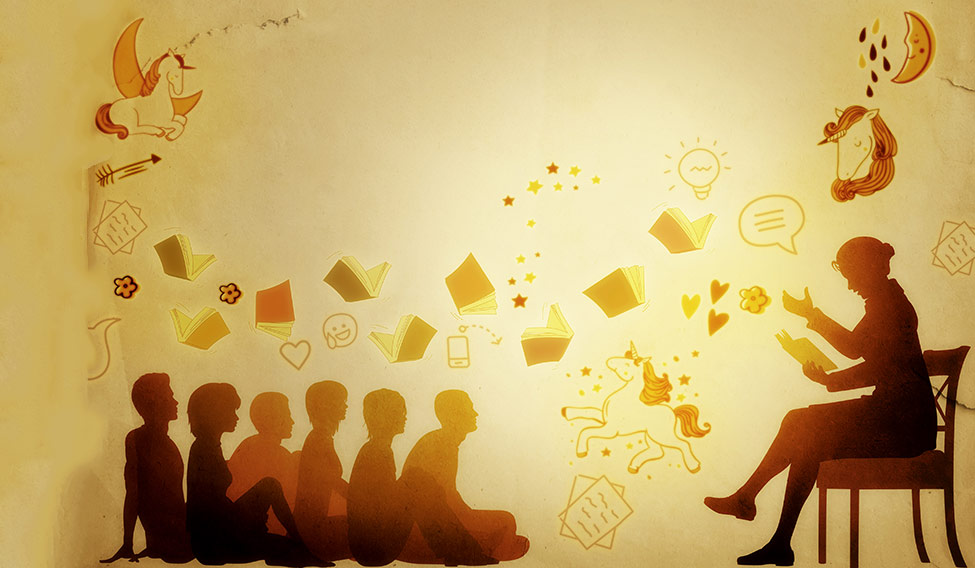What you have just started reading is a story. A story about storytelling. It has been said that the need to tell and hear stories is essential to human beings: second in necessity, placed after nourishment and before love and shelter.
“The most important impact of storytelling is the increase in empathy, both for the teller and listener. It has been proven,” says Giles Abbott, an award-winning storyteller from the United Kingdom. He visited India in November as part of Kathakar: International Storytelling Festival, organised by the Indira Gandhi National Centre for the Arts in collaboration with the NGO Nivesh in nine Indian cities.
The tales that make up our world are of all kinds: fairytales, reportage, advertising, mythology, songs, scripts, fables, fiction, prose, poetry—from classics to the contemporary and popular to the niche—a form of communication as old as civilisation that started even before writing. Storytelling was part of religious rituals, came from rock art in ancient cultures, and was found even in complex forms of tattooing.
Storytelling saw a global revival in the 1960s, especially in the United States and the UK, where people felt a need to directly connect as human beings, with their histories, culture and nature, at a time when television had overtaken much of their entertainment. A similar trend is beginning to emerge in India now, especially in the metros, as the digital world serves as both a divide and a bridge in human interactions.
“A growing interest in the form has, for instance, given reason for the sixth edition of Kathakar festival this year,” says Mangalam Swaminathan, programme director, IGNCA. “As traditional sources dry up and families go nuclear in India and globally, parents want children to learn. Schools are encouraging professional storytellers in classrooms. Both adults and children enjoy listening to stories.”
Storytelling in the UK was destroyed by the industrial revolution, explains Abbott, who began storytelling in 1999 as a response to a sudden partial loss of sight. He went on to become the country’s only blind professional storyteller. “In the 1980s, it saw a revival in the UK when people could make a living from it. In India, I feel the form never totally died out, similar to African and native American culture. And, the interest is growing here too, now.”
Raconteur and academic Vayu Naidu, the first Indian to be awarded a PhD in performance oral tradition from the University of Leeds, says storytelling in India is continually evolving both in content and context, repositioning the status of tellings and tellers. “That is the excitement. A new generation of urban storytelling is gathering momentum in metros; revivals or rediscoveries, both are most welcome,” she says.
In urban India, storytelling is being harnessed for several streams: entertainment, information, therapy, education and business. “Groups of storytellers are seeking significances of myths as a shared source across cultures,” says Naidu. “Someone like a Devdutt Pattanaik does it in all streams. The traditional storytellers had music and that too is bridging with new technologies for wider audiences—the thrill of the shared story, told well, is the only tradition. Telling a story well is taking the ‘context’—content, intention, story, audience—into account and playing with it. Bad tellers hack and ham, good tellers fly.”
Storytelling is a pool, she says, the listener sees the teller in listening, and the teller is really a listener of life’s dance with fire.
India, with its vast traditions and rich cultures, holds up a diverse storytelling tradition: from the revival of Dastangoi in Delhi, radio stories from an imaginary Uttar Pradesh city, the Punjabi qisse, Bhands travelling across north India, Rajasthan’s kawad tradition, Akhyan—the performing poetry form in Gujarat—to the ancient Villupattu of Tamil Nadu-Kerala, Burrakatha of Andhra Pradesh, Pandavani of Chhattisgarh, healing tradition of Shamanism in Darjeeling, the mysticism of the Baul singer from West Bengal, to subverting popular fairytales in the city of Mumbai, live narration of grandma’s tales on Facebook from Bengaluru or telling a city through its legends in Chennai and more.
Going forward, could India consider storytelling a major cultural legacy? “We would be arrogant to consider ourselves the best because we have a heritage of storytelling. We need to listen to ourselves and reflect on diverse programmes of storytelling worldwide,” says Naidu. “Storytelling is a deep and incisive form. It is alchemy in all its forms. So storytellers should be wary of radicalisation and propaganda, and every storyteller should ask: ‘Am I making heaven out of hell? What the hell is this story about? How in heaven do I tell it?’ Dig deep and the story fountain will flow.”
Meanwhile, turn the page to learn how some storytellers across India are changing our world, one story at a time.








